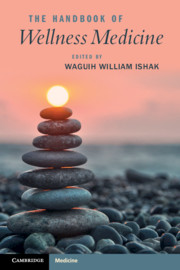Book contents
- The Handbook of Wellness Medicine
- The Handbook of Wellness Medicine
- Copyright page
- Dedication
- Contents
- Contributors
- Part I Approach to Wellness
- Part II From Illness to Wellness by Organ Systems/Disorders
- Part III Special Populations and Special Topics
- Part IV Wellness Interventions
- Part V Wellness through Optimization of Work, Love, and Play
- Chapter 45 Work, Love, Play, and Joie de Vivre
- Chapter 46 Well-Being and Work–Life Balance
- Chapter 47 Family Relations, Friendships, and Love
- Chapter 48 The Role of Leisure, Recreation, and Play in Health and Well-Being
- Chapter 49 Wellness and Whole-Person Care
- Chapter 50 The Personalized Wellness Life Plan
- Book part
- Index
- References
Chapter 45 - Work, Love, Play, and Joie de Vivre
from Part V - Wellness through Optimization of Work, Love, and Play
Published online by Cambridge University Press: 18 September 2020
- The Handbook of Wellness Medicine
- The Handbook of Wellness Medicine
- Copyright page
- Dedication
- Contents
- Contributors
- Part I Approach to Wellness
- Part II From Illness to Wellness by Organ Systems/Disorders
- Part III Special Populations and Special Topics
- Part IV Wellness Interventions
- Part V Wellness through Optimization of Work, Love, and Play
- Chapter 45 Work, Love, Play, and Joie de Vivre
- Chapter 46 Well-Being and Work–Life Balance
- Chapter 47 Family Relations, Friendships, and Love
- Chapter 48 The Role of Leisure, Recreation, and Play in Health and Well-Being
- Chapter 49 Wellness and Whole-Person Care
- Chapter 50 The Personalized Wellness Life Plan
- Book part
- Index
- References
Summary
In conceptualizing lifestyle approaches to promote health and well-being, most attention is paid toward physical rituals, including physical activity, dietary modification, and cessation of drugs and alcohol. Less discussed are the fundamental aspects of work, play, and love that have the potential to promote – or erode – overall health and wellness. These factors may, in certain cases, play an even more profound role in wellness than traditional physical practices. “Joie de vivre” is a term used to describe overall enjoyment of life, and in a sense, encompasses all three domains.
- Type
- Chapter
- Information
- The Handbook of Wellness Medicine , pp. 535 - 544Publisher: Cambridge University PressPrint publication year: 2020



